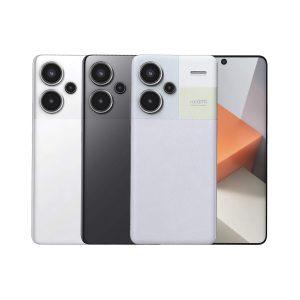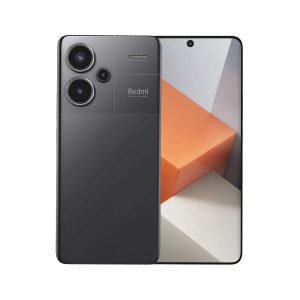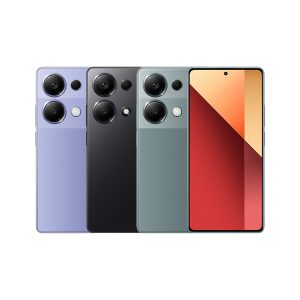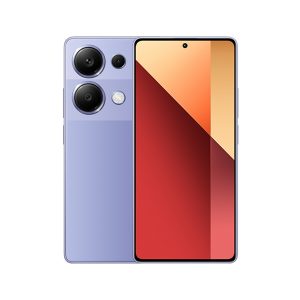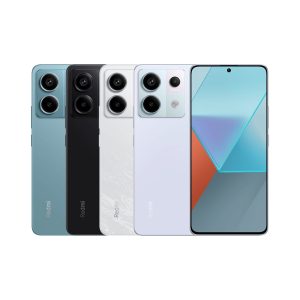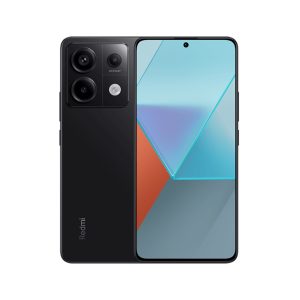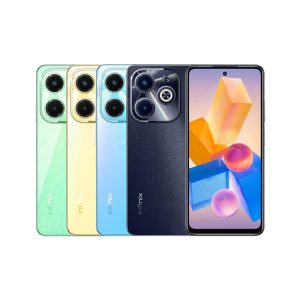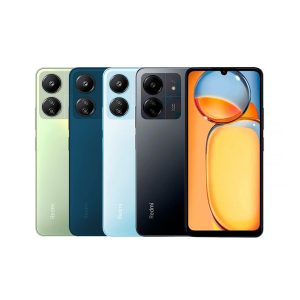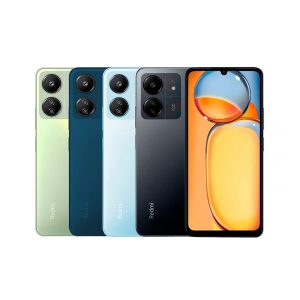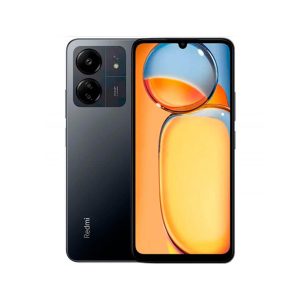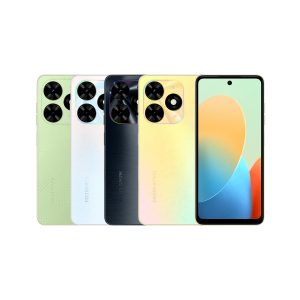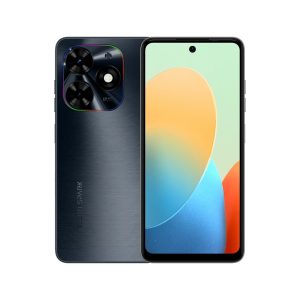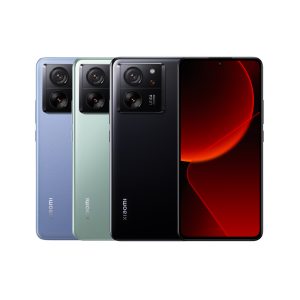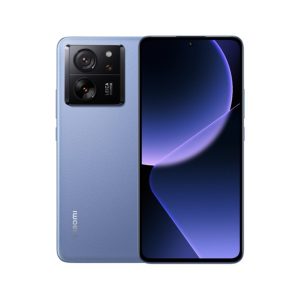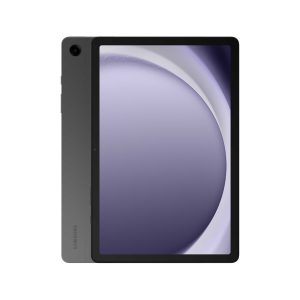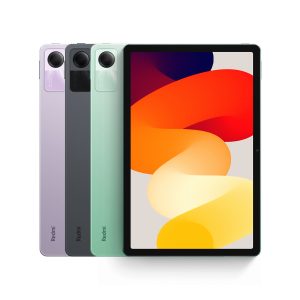Samsung Galaxy A15 LTE
The Galaxy A15 LTE 6.5-inch Super AMOLED display boasts vibrant clarity even in direct sunlight with Vision Booster, smooth-scrolling with improved 90Hz refresh rate, enhanced brightness up to 800 nits, and all-day comfort with reduced blue light thanks to Eye Comfort Shield.
Designed to fulfill. The Galaxy A15 showcases its refined aesthetics through an intuitive frame, glossy back cover, and tidy camera layout. Available in Blue Black, and Light Blue.Go on and express your world. The Galaxy A15 boasts a 50MP Main camera for your masterpiece, 5MP Ultra Wide and 2MP Macro cameras for landscapes and close-ups, and a 13MP Front camera for profile-worthy selfies.
Stay up and running with a copious 5,000mAh (typical) battery that recharges with Super Fast Charging to get you back out on the road.
Xiaomi Redmi Note 13 Pro+ 5G
The Redmi Note 13 Pro+ 5G, shares a similar 6.7-inch OLED screen and MIUI software as the rest, it stands out with a much faster chip, insane 120W fast charging, beautiful design and a few other notable features.
Other attractions of the Redmi Note 13 Pro+ include an upgraded 200MP primary camera with OIS (optical image stabilization), MediaTek’s 4nm-based Dimensity 7200 Ultra SoC, an IP68 rating for dust and water resistance, up to 12GB of LPDDR5 RAM, and 512GB of UFS 3.1 storage.
Speaking of the display, the 6.67-inch AMOLED screen offers a sharp viewing experience with 1.5K resolution (2,712 x 1,220 pixels) and up to 1800 nits peak brightness. There’s also support for HDR10+ and Dolby Vision for an immersive movie viewing experience. Xiaomi is taking cues from its competitors and maintaining a high PWM dimming to up to 1,920Hz for a reduced flicker on the screen. The display also offers 120Hz refresh rate for a smooth gaming and scrolling experience.
While there’s no Leica partnership in Xiaomi’s mid-range (yet), the Redmi Note 13 Pro+ includes an upgraded 200MP primary camera. For instance, it now utilizes an ISOCELL HP3 sensor (the previous being the ISOCELL HPX sensor), which captures sharper details and more light. As a result, when you zoom in, photos captured in 200MP mode exhibit clearer details, less noise, and more readable text at a distance. Naturally, the file size also increases when you click photos in this mode.
Xiaomi Redmi Note 13 Pro 4G
This particular review is for the middle child in this family of five, the Redmi Note 13 Pro 4G. Notice the lack of 5G in the name and in the feature set, but also notice that this is a "Pro" phone. For this particular series, the Pro series indicates an improved 200MP main camera sensor and a faster chip inside the phone.
As for all the rest, the Redmi Note 13 Pro is a big phone with a 6.7-inch 120Hz OLED screen and it also has a 5,000mAh battery, just like all five phones in the series.
Xiaomi Redmi Note 13 Pro 5G
The Xiaomi Redmi Note 13 Pro 5G is the second best in this family of five. It bets on a capable 200MP main camera, a zippy Snapdragon 7s Gen 2 processor, and a big and sharp 6.7-inch display.
Speaking of the 6.7-inch size, this is part of the common DNA in the Redmi Note 13 series, and others include fast charging and, of course, the MIUI software.
Infinix Hot 40i
The Infinix hot 40i, coming from its predecessor, the Infinix HOT 40i sports an improved design, bigger memory configuration, and better camera hardware.
In particular, the device sports a 6.56-inch LCD (IPS) screen with a 90Hz refresh rate, HD+ resolution, and a top-center punch-hole for its 32MP selfie camera.
Under the hood, the handset features a 12nm UNISOC T606 chip with 8GB RAM, 8GB virtual RAM (for a total of up to 16GB RAM), 128GB or 256GB expandable storage, and a 5,000mAh battery capacity with USB-C 18W fast charging.
The primary camera highlights a large 50MP sensor paired with an AI secondary camera helper.
Other specs include a side-mounted fingerprint reader, up to 200% Super Volume speaker, WiFi, 4G LTE, Bluetooth, and dual SIM slots.
This also has the XBOOST Gaming Engine and runs with Android 13 OS with XOS 13 skin on top.
Tecno Spark 20C
The Tecno Spark 20C, is a stylish device geared towards entry-level consumers. It comes in different colorways such as Gravity Black, Mystery White. At the front, it has a 6.6-inch LCD (IPS) screen with HD+ 1612 x 720 resolution and a 90Hz refresh rate. Its punch-hole camera uses 8MP for selfies and video calls. Moreover, TECNO developed its own Dynamic Island feature that will show notifications for battery, charging, and more.
Inside, TECNO has been quiet on its processor and only mentioned of "octa-core" CPU. But it uses 4GB RAM + 4GB virtual RAM or 8+8GB combo and 128GB single storage option.
For battery, it has a 5,000mAh capacity that charges using the 18W power brick and a USB-C cable.
For the rear camera, it is using a 50MP primary shooter coupled with an AI lens for depth shooting.
Other features noted are the side-mounted fingerprint sensor and a dual speaker setup with DTS sound which can be boosted to 400 percent volume.
Connectivity-wise, it has 4G, WiFi (2.4GHz/5GHz), Bluetooth, FM, GPS, OTG and dual SIM support.
For software, the phone runs Android 13 Operating System.
Xiaomi Redmi 12C
The Xiaomi Redmi 12C is a mid-range smartphone from Xiaomi, released in January 2023. Although not as powerful as some of their flagship models, it still offers great features and performance at an affordable price. The Redmi 12C has a 6.71 inch LCD IPS screen with a resolution of 720 x 1650 (HD+) and 500 cd/m² (typ) brightness, 1500:1 contrast ratio, and 82.2% usable surface. It is made of plastic material and looks stylish.
Under the hood, the Redmi 12C is powered by the MediaTek Helio G85 (MT6769V/CZ) (12nm) processor paired with 4GB, 6GB or 3GB of LPDDR4X RAM and 64GB or 128GB of eMMC 5.1 storage. It also supports external storage via a microSD card in a slot card tray. On the benchmarking front, it scored 251300 on AnTuTu v9.
In terms of camera, the Redmi 12C features a dual-camera setup which consists of a standard 50.0MP f/1.8 CMOS sensor and a macro lens with 2.0MP f/2.4. It also has a 5MP selfie shooter. Connectivity-wise, it comes with Bluetooth 5.1, dual SIM, audio jack, and infrared.
For power, the Redmi 12C packs a 5000mAh battery and supports 10W fast charging. This should be enough to get you through a day of usage with ease.
Overall, the Xiaomi Redmi 12C is a great mid-range smartphone from Xiaomi that offers good performance at an affordable price. It looks good, is well-built and has good connectivity options. It has decent cameras and can perform well in gaming and multitasking. The battery backup should also be good. If you’re looking for a budget-friendly phone with good features, the Redmi 12C could be a great choice.
Xiaomi Redmi 13C
The Xiaomi Redmi 13c, among the main characteristics of the Redmi 13C are a 6.74-inch screen with a frame rate of 90 Hz, a 5 MP front camera, a main triple camera (50 MP, 2 and 2 MP), MediaTek Helio G99 SoC, a 5000 mAh battery with 18W charging support. The 13C packs a 8MP front-facing camera; around the back, there's a 50MP f/1.8 main shooter and a 2MP macro. The 5,000mAh battery takes 18W charging but there's a 10W brick in the box.
Tecno Spark Go 2024
The TECNO Spark Go 2024. It’s the refreshed version of its 2023 predecessor, now sporting a better chipset, a revamped design, and ‘Dynamic Island’-inspired feature. The new model equips the UNISOC T606 chipset packing improved performance (compared to its 2023 version with MediaTek Helio A22).
Design-wise, it comes with a new camera module layout at the rear and the back panel appears in pastel-like colors. Its 6.6-inch HD+ display now operates at 90Hz which is a nice upgrade in its tier. Additionally, its notch is now a punch-hole (previously, dewdrop) featuring Tecno’s self-developed ‘Dynamic Port’—a quirk inspired from Apple’s Dynamic Island.Xiaomi 13T Pro
The Xiaomi 13T Pro which is packed with the latest hardware and a set of Leica-powered cameras — all under a price tag very few other flagship smartphones have dared to cross.The Meadow Green and Black models have a glossy glass back panel that’s reminiscent of the design of the Xiaomi 13. One difference here is that the leather version is slightly thicker at 8.62mm vs. 8.49mm on the other two. Conversely, the Alpine Blue is actually lighter at just 200 grams vs. 206 grams on the glass variants. The power button and volume rocker are found on the right side; stereo speaker grills, primary mic, USB Type-C port and SIM card slot are found at the bottom; secondary speaker grill, noise-canceling mic and IR blaster up top.It has a flat 6.67-inch CrystalRes Display supporting up to 144Hz refresh rate and 1.5K or 2712 x 1220 pixel resolution.
This display greatly improves the viewing and gaming experience, thanks to a high brightness mode of up to 1200nits and a peak brightness of up to 2600nits, along with 100% DCI-P3 coverage with 68 billion colors. Xiaomi 13T Pro also supports end-to-end HDR10+ and is protected by Corning’s Gorilla Glass 5. The dual speakers support Dolby Atmos which makes it more immersive than regular stereo speakers.
In terms of the camera, the Xiaomi 13T Pro packs a 50MP 24mm f/1.9 wide angle camera with OIS, 50MP 50mm f/1.9 telephoto camera with 2x optical zoom, and 12MP 15mm f/2.2 ultrawide camera. The Xiaomi 13T Pro is tuned by Leica, a popular camera brand, you can choose between two photographic styles — Leica Authentic Look which produces images has a little boost in contrast; and Leica Vibrant, which give you a little bit more vibrancy in every shot.
Samsung Galaxy Tab A9+ 5G
The Samsung Galaxy Tab A9+ comes with a 11-inch WQXGA LCD screen with a 1,920 x 1,200 resolution, and a 90Hz refresh rate. Inside is the 8nm Qualcomm Snapdragon 695 octa-core processor, Adreno 619L GPU, 8GB RAM, 64GB/128GB, and a 7,040mAh battery with 15W adaptive fast charging. It comes with AKG-tuned quad-speakers and in front of the tablet is a 5MP front-facing camera.
Xiaomi Redmi Pad SE
The Xiaomi has officially released the Redmi Pad SE in the Philippines. It features an 11-inch display with adaptive 90Hz refresh, 8000mAh battery, and equips the Snapdragon 680 SoC. The chipset is a Snapdragon 680, built on the 6 nm process technology. It is a fairly old platform, as it arrived in early 2021, but we don't expect a powerhouse in this price category. In fact, this could be a great SoC for the Redmi Pad SE – we'll know for sure once we go through our regular tests and benchmarks. Our first impressions from the performance are the UI is smooth, and the 90 Hz could prove itself worthy when browsing or using the native player.
Xiaomi introduced MIUI Pad 14, which is an adapted version of MIUI 14 for big screens. Тhe apps feel native and not stretched; video also looks good. The 11” LCD is certified for low blue light, meaning it would be a great device for reading and learning. In theory, it can reach 400 nits and 1500:1 contrast, but once again, we have to use our own tools to determine how authentic these results are in real-life scenarios.
There are four speakers with Dolby Atmos and Hi-Res Audio support, placed 2x2 on the right and left side (when held horizontally), and we are quite happy to see a 3.5 mm audio jack. The battery has an 8,000 mAh capacity, which sounds promising for an endurance test. However, it is rated for 10W, meaning it would take some time for the cell to get from 0 to 100% with the charger provided in the box.



